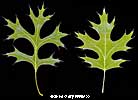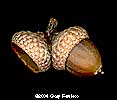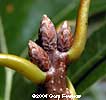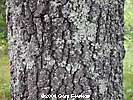
Trees of Wisconsin
|
Quercus ellipsoidalis E.J.Hill Hill's oak Family: Fagaceae |
||||||||||||
|
||||||||||||
|
The leaves of Quercus ellipsoidalis are simple, alternate and sharp-lobed. It can be distinguished from Quercus rubra by the deep sinuses and shiny surface of the former compared to the shallow sinuses and (often) dull surfaces of the latter. The leaves of Q. ellipsoidalis are similar to those of Q. coccinea, Q. palustris and Q. velutina. The first two are very rare in southern Wisconsin and Q. velutina is more common, but is mostly southern also. Oaks with deep lobes and sharp tips north of Green Bay are likely to be Q. ellipsoidalis. See the key for specifics on identification, or go to the Flora of North America treatment on the web for more information. Click here to compare the leaves of our 6 commonest species of oaks (but be warned that there is considerable variation in each species). Quercus ellipsoidalis is apparently closely related to Q. coccinea, but the latter barely enters southern Wisconsin. Quercus ellipsoidalis is found throughout the state, although it is apparently rare in the north central area where it is occasionally found along the Wisconsin River. It is intolerant of shade and is most abundant on dry, acid, sandy soils, but is sometimes also found on heavier soils. It sprouts vigorously from stumps when cut and many of the trees in northeastern Wisconsin are multiple-stemmed, apparently derived as stump sprouts from cut or burned plants. The growth form is much bushier under those circumstances than is true of uncut individuals (see photos above). |
|






